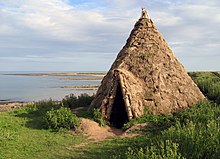Howick Stone Age Hut
The Howick Mesolithic Stone Age hut on the North Sea in Northumberland , England , was discovered when amateur archaeologists reported large quantities of flint artifacts on a Howick Burn cliff.
Archaeologists from the University of Newcastle-upon-Tyne found the remains of a hut between 2000 and 2002 with evidence of three different phases of construction. 21 radiocarbon dates from the hearth show that the hut was built around 7800 BC. BC and was used for at least 100 years. It remains to be seen whether the use was permanent, semi-permanent or seasonal. Continuous stratigraphy suggests that there were no significant gaps between uses. The structural evidence has shown that the hut was renewed twice on the same site. It is the oldest evidence of human habitation in Northumberland and one of the few documented Stone Age dwellings in the British Isles . Over 18,000 flints as well as charred hazelnut shells , animal bones and red chalk were recovered during the excavations. The location of all finds was recorded and all debris sifted. The result of Howick represents one of the most detailed Mesolithic excavations in Europe.
reconstruction
In 2005 the archaeologists responsible for the excavations in Howick created a reconstruction of the Stone Age hut on the site of the original. The construction turned out to be very useful from an experimental point of view.
See also
Web links
Coordinates: 55 ° 26 ′ 32.6 " N , 1 ° 35 ′ 34.4" W.

